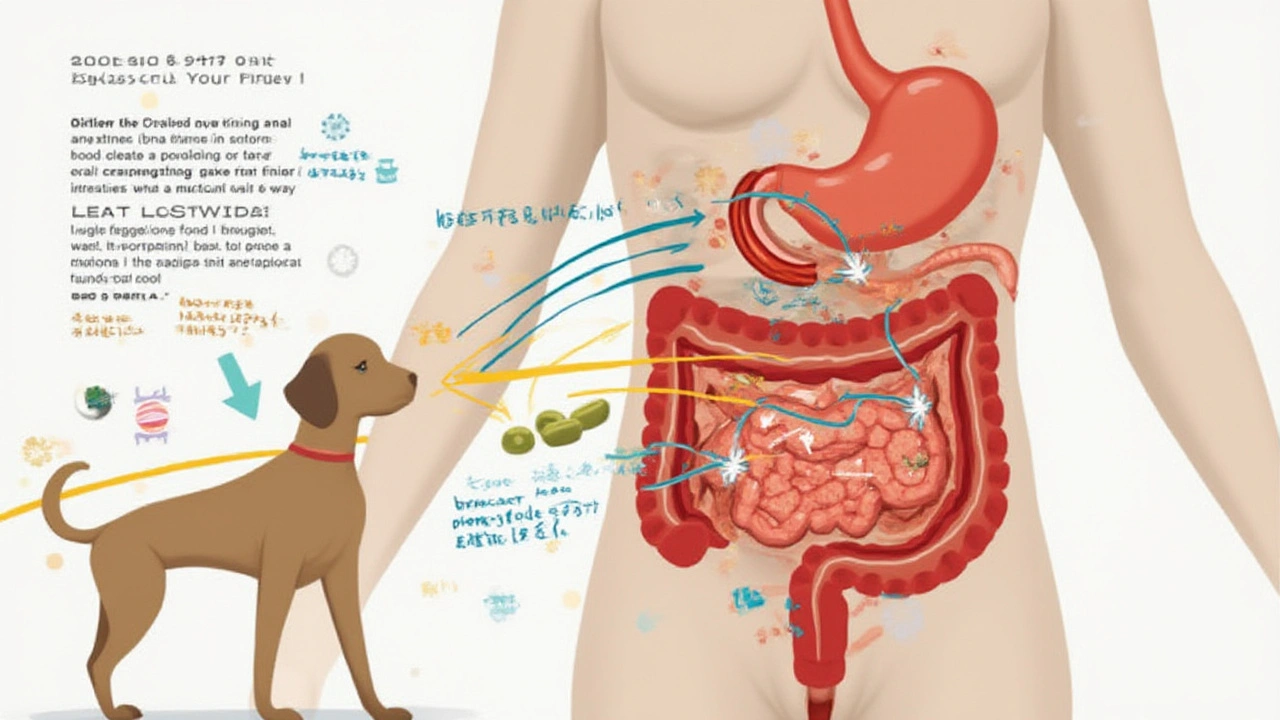You probably know at least one person who’s tried to lose weight using a pill. Some swear by their results, others say it’s all hype. But when I first read the fine print on the back of an Orlistat box at the pharmacy, the bold promise — “blocks up to 25% of dietary fat from being absorbed” — definitely stood out. Sometimes it feels like every week there’s a new miracle weight loss product, but Orlistat’s been on the market for years, which makes you wonder: does this one actually work, or is it just another overhyped hope?
What is Orlistat and How Does It Work?
Orlistat is a weight loss drug — but not like those sketchy metabolism boosters or old-fashioned ‘appetite suppressants’ you might remember from shady online ads. Orlistat’s main move isn’t about speeding up your heart or killing your cravings. This pill has a rather direct approach: it blocks your guts from absorbing some of the fat you eat. If your plate looks like a family-size pizza or extra cheesy mac and cheese, Orlistat just interrupts the fat’s journey, sending a lot of it straight out the other end — literally.
It works as a “lipase inhibitor.” That means it grabs onto enzymes in your intestine that break down fats. When those enzymes are busy with Orlistat, about a quarter of your dietary fat can’t get digested, so your body doesn’t take it in. Instead, that fat passes through you. The effect is real — clinical studies actually show it can block around 25% to 30% of fat absorption if you take it as directed.
There are two familiar names on the pharmacy shelf. The prescription version, called Xenical, packs 120mg per pill. The other — Alli — is a lower-dose, non-prescription option, with 60mg per pill. The FDA gave Alli the green light over-the-counter in 2007, making it one of the few legit diet pills you can buy without a prescription.
Orlistat isn’t magic, but studies found that adults using it, combined with a calorie-reduced diet, lost three to five pounds more (on average) than folks only dieting, over one year. The weight loss isn’t jaw-dropping, but for some, it’s enough to make clothes fit looser or numbers drop on the scale. If you stick with it beyond a year, you can usually maintain double the weight loss compared to diet alone. But there’s a catch: stop taking Orlistat, and weight tends to creep back up unless you also keep those healthy habits.
Here’s a look at how Orlistat lines up, broken down in a simple stat table:
| Drug Brand | Dosage per Pill | Status | Fat Blocked |
|---|---|---|---|
| Xenical | 120mg | Prescription | ~30% |
| Alli | 60mg | Over-the-counter | ~25% |
The idea itself sounds weird — blocking fat from being absorbed instead of burning it away — but that’s why Orlistat stands out from other diet pills.
Who Should Consider Orlistat?
If your kid’s soccer coach or your cousin’s friend swears by keto and three hours at the gym, you may wonder who Orlistat is actually for. The short answer: it’s not meant for people looking for a ‘quick fix’ or a small tweak in their waistline. Orlistat is designed for adults struggling with real weight problems — usually called “obese” in doctor speak, meaning a BMI of 30 or higher, or 27+ with other health issues (think high blood pressure or type 2 diabetes).
Doctors usually recommend at least six months of regular diet and exercise effort first. If nothing moves the needle, and the person is committed to ongoing lifestyle changes, Orlistat might be added to the mix. It’s not meant for kids, teens, or anyone pregnant or breastfeeding. There are studies that suggest it can help certain adolescents with severe obesity, but only under specialist care.
If you take Orlistat, you’re also agreeing to a few ground rules. You’ll have to stick with a lower-fat diet (less than 30% of daily calories from fat) to avoid some truly miserable side effects. You’ll need to space out your main fat-soluble vitamin (A, D, E, and K) supplements apart from the pill, because Orlistat also makes it harder to absorb those nutrients. People with gallbladder problems, chronic malabsorption, or anyone on a transplant anti-rejection drug like cyclosporine should stay away completely.
It isn’t a cure for emotional eating, binge behaviors, or deep-seated stress patterns around food. If you struggle with any of those, Orlistat won’t solve it; the focus is strictly on blocking a chunk of dietary fat absorption.

What Results Can You Expect on Orlistat?
Don’t expect red carpet before-and-after shots. The weight loss is real, but slow and steady rather than jaw-dropping. Clinical trials show that people who use orlistat with a sensible diet drop about 5% to 10% of their starting weight in a year. For a 200-pound person, that’s anywhere from 10 to 20 pounds — more if you stick with the program after the first 12 months.
Now, here comes the hard truth. Most of that loss happens in the first six months to a year. If you stop Orlistat, your body absorbs fat as usual and weight often bounces back unless you make lasting changes to diet and habits. Consistency matters — if you’re someone who struggles to remember daily pills or tends to yo-yo on diets, Orlistat’s extra boost only works with regular use and real lifestyle changes.
One bonus that doesn’t show up on the scale: Orlistat may help modestly lower bad cholesterol levels and blood pressure. Certain studies also point out improvement in sugar levels for those with type 2 diabetes. These side effects make it more appealing for people with metabolic issues tied to weight.
But this isn’t a miracle drug. Most people see results only when they cut daily calories and mind their fat intake. If you keep eating greasy burgers every meal? Not only does Orlistat not help — it punishes you (more on that below). So the most successful folks using it usually keep snacks simple, choose lean protein over fatty meats, and go easy on oils, cheeses, and processed treats.
Here’s a tip straight from people who’ve used the medication: Read food labels, keep fat grams low at every meal (ideally no more than 15 grams per meal), and don’t skip meals. The pill works best when taken with main meals — not snacks, not on an empty stomach — because you need some dietary fat present for it to grab onto AND block.
For parents with teens in the house (like my son Tristan), keep those conversation lines open about what healthy weight loss looks like. Orlistat is strictly adult territory except in rare, specialist-supervised cases for older teens.
Side Effects Nobody Talks About
Let’s be real — the main reason Orlistat infomercials don’t show before-and-after bathroom runs is because of what doctors call “gastrointestinal events.” Translation: farting, gas with oily discharge, urgent diarrhea, and stools that sometimes look straight out of an oil spill. This isn’t rare. It’s actually the most common reason people quit taking Orlistat early on. When you block up to 30% of the fat from being absorbed, a lot of that fat needs to go somewhere. It shows up in the toilet. Some have called these effects “treatment effects” (not dangerous, just embarrassing or uncomfortable).
The first two weeks on Orlistat are by far the worst. If your diet was high in greasy foods before starting, you’ll get hit harder. Over time, your gut learns — and so do you. People quickly cut out fried foods after a public incident or two. Eating a lower-fat diet, as recommended, cuts these risks way down, so it’s actually a built-in incentive to eat smarter.
Another important tip: Don’t skip meals, thinking it’ll prevent the ‘treatment effects.’ Orlistat should only be taken with meals that have some fat, and the more consistently you spread out your food intake, the less likely you’ll get nasty surprises later on.
Less common risks include rare liver injury (watch for yellowing skin/eyes, dark urine), kidney stones, and fat-soluble vitamin deficiencies. Your doctor might check your liver tests if you take it long-term or have any weird symptoms. To avoid vitamin shortages, take a multivitamin at bedtime, several hours after your last Orlistat dose.
Some people on blood thinners (like warfarin) or those who take drugs for thyroid issues may need closer monitoring, as Orlistat can interact with certain meds. Always talk with your doctor or pharmacist before starting — and don’t believe those shady online shops selling ‘extra-strength’ Orlistat knockoffs.

Tips for Getting the Most from Orlistat
If you’re going to pay for a prescription and deal with the side effects, you want to make Orlistat worth it. Here’s what works, straight from people who’ve survived the first bottle:
- Read food labels: Start with fat grams per serving. Aim for no more than 15 grams of fat per main meal, and total daily fat under 45 grams if possible.
- Spread fat intake: Don’t save all your fat for dinner. Split it roughly equally among breakfast, lunch, and dinner to dodge surprises.
- Take Orlistat with food: Pop the pill either with, or up to an hour after, your meal — but make sure the meal has some fat in it (5 grams minimum).
- Don’t skip meals: You’ll just feel hungrier later, which makes sticking to the plan harder.
- Plan meals around lean proteins and veggies: Chicken, fish, legumes, broccoli, peppers, spinach — these should be staples. Avoid creamy sauces, dressings, and fried add-ons.
- Carry spare clothes or supplies the first week, just in case you get hit with those ‘treatment effects’ at work or school.
- Take a daily multivitamin at bedtime to cover for lower fat-soluble vitamin absorption.
- Monitor for drug interactions: Tell your healthcare provider about all supplements and meds. Orlistat can affect oral cyclosporine, amiodarone, and other medications.
- Alcohol isn’t banned, but go easy — lots of mixed drinks are loaded with calories and hidden fats.
- Have a plan for social events — check menus and snack options ahead of time, and keep Orlistat doses on schedule.
And one more thing: don’t double up on missed doses. If you forget a serving and it’s been more than an hour since you ate, just skip and move on.
If you’re going through a stressful time at home or work (as I know all too well juggling family and a writing gig), acknowledge those patterns, too. Meds like Orlistat help, but they can’t carry you through lifestyle chaos. Use any weight loss journey as a spark to rethink daily routines, get your family moving more, and treat yourself with trust and patience.
Orlistat can be a helpful tool in your weight loss toolbox — but it’s not a miracle shortcut. Knowing the facts, using it as intended, and being honest about your diet choices will help you decide if it’s right for you, not just a gamble based on a flashy label.




Tiffany Fox, July 4, 2025
Been on Alli for 8 months. Side effects sucked at first, but cut the fried food and now it’s just a quiet tool. Lost 18 lbs, no magic, just consistency.
Rohini Paul, July 4, 2025
So it’s basically a fat filter? Wild. I tried it once, ate a greasy biryani, and spent an hour in the bathroom wondering if I’d been poisoned. Not worth the drama for me.
Courtney Mintenko, July 5, 2025
Orlistat is capitalism’s way of selling you a toilet as a solution to your soul’s hunger. You’re not fat you’re just fed wrong. The real problem is you don’t know how to sit with yourself. The pill just makes your ass leak.
Khamaile Shakeer, July 7, 2025
LOL so you’re telling me I gotta eat less fat to make a pill that makes me fart work?? 🤡 I thought this was gonna be like, magic fat fairy dust. Also, why does everyone say ‘treatment effects’ like it’s a spa day?? 😂
Suryakant Godale, July 7, 2025
While the pharmacological mechanism of Orlistat is well-documented, one must consider the broader implications of pharmacological intervention in metabolic regulation. The reliance on enzymatic inhibition may inadvertently undermine long-term dietary autonomy. Furthermore, the gastrointestinal adverse effects, while predictable, represent a significant barrier to adherence, particularly in populations with limited access to nutritional counseling.
John Kang, July 8, 2025
Just keep it simple. Take the pill with meals that have fat. Eat more chicken, less cheese. Drink water. Sleep well. It’s not rocket science. You got this.
Bob Stewart, July 10, 2025
Orlistat’s efficacy is statistically significant in randomized controlled trials when combined with caloric restriction. However, its clinical utility is limited by low long-term adherence due to gastrointestinal adverse events. Vitamin supplementation timing is critical to prevent deficiencies. The over-the-counter formulation lacks sufficient patient education infrastructure.
Simran Mishra, July 11, 2025
I tried Orlistat after my divorce. I thought it would fix everything. The first time it happened - you know, the thing - I was at a work meeting. I didn’t speak for three days. I cried in the parking lot. I thought I was broken. I stopped taking it. But then I started therapy. And I started cooking. And now I eat kale. And I’m not fixed. But I’m not leaking anymore. And that’s something. I just wanted someone to say it’s okay if it doesn’t work. It’s okay if you hate your body. It’s okay if the pill makes you feel worse. I just needed to hear it.
ka modesto, July 13, 2025
Biggest tip I got: take your multivitamin at bedtime. I kept forgetting and got super tired. Once I fixed that, I felt way better. Also, don’t skip meals - you’ll just binge later. Been on it 10 months, lost 22 lbs. Not perfect, but better than before.
Holly Lowe, July 14, 2025
Orlistat is the gritty, greasy, gas-powered sidekick of weight loss - not the hero, but the one who shows up even when you’re a mess. It doesn’t sparkle. It doesn’t sing. But it shows up. And sometimes, that’s enough.
Cindy Burgess, July 16, 2025
Given the documented attrition rate associated with gastrointestinal adverse effects, the risk-benefit profile of Orlistat remains contentious in populations without comorbid metabolic conditions. Long-term data suggest minimal sustained advantage over behavioral intervention alone.